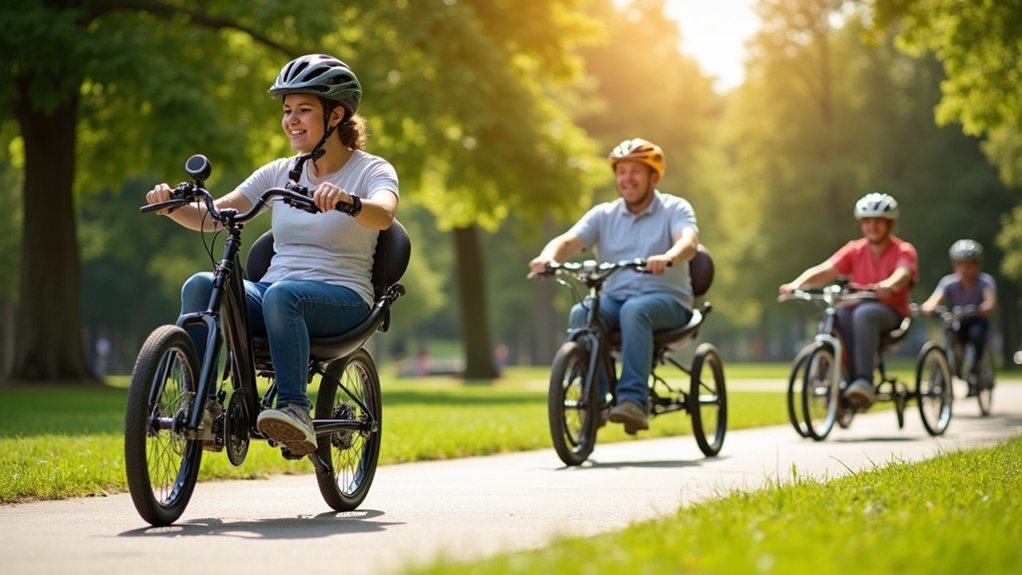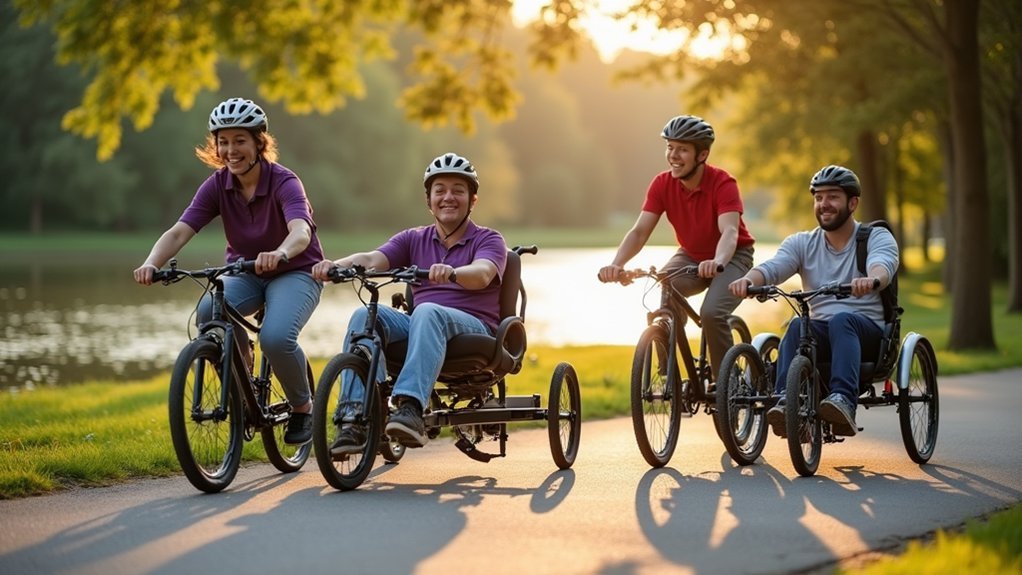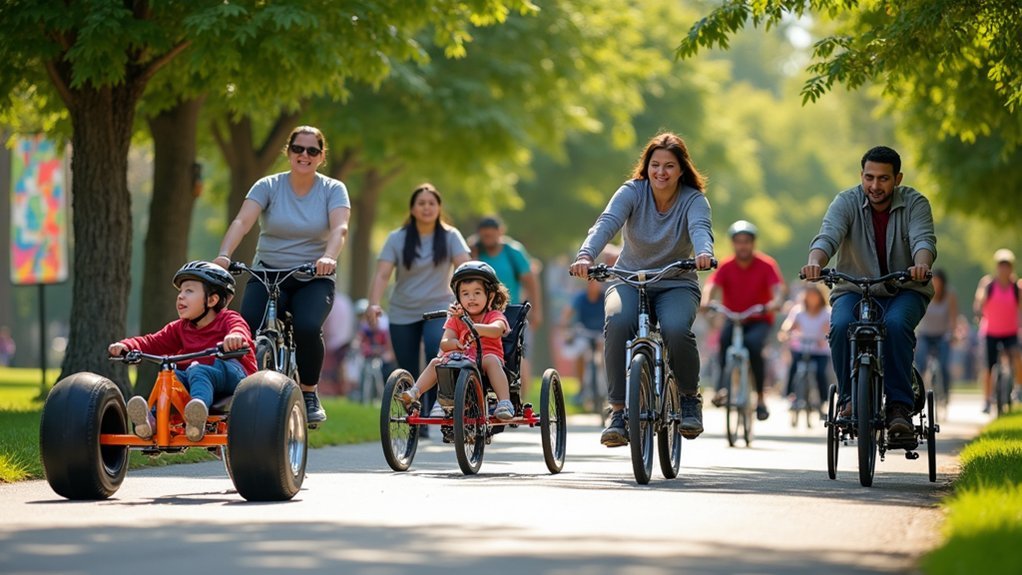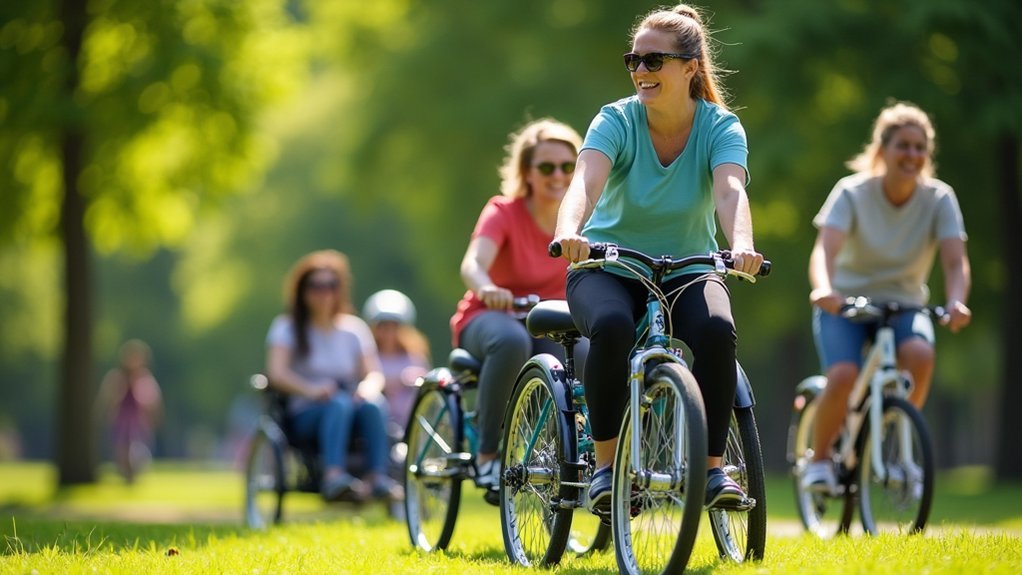Disabled riders have access to numerous adaptive cycling options tailored to specific needs. You’ll find tricycles for stability, handcycles for limited lower body mobility, wheelchair-compatible cycles, tandems for guided riding, and modified standard bikes with customized controls. These solutions offer therapeutic benefits beyond exercise—improving cardiovascular health, independence, and mental wellbeing. Many adaptive sports organizations provide equipment trials and training to help you find your perfect match. Discover how these specialized cycles are transforming lives across all ability levels.
Understanding Types of Adaptive Cycles

Accessibility in cycling has evolved dramatically with specialized equipment designed for riders of all abilities.
You’ll find numerous options tailored to specific needs and physical capabilities.
Adaptive tricycles offer superior stability with their three-wheel design, available in both adult and child versions.
Adaptive tricycles revolutionize cycling accessibility, providing unmatched stability through thoughtful three-wheel engineering for riders of all ages.
For wheelchair users, specialized bikes allow for direct transfer or even accommodate the entire wheelchair as a passenger component.
Hand cycles serve riders with limited lower body mobility, featuring hand-crank mechanisms instead of foot pedals, often in recumbent positions for comfort.
Tandem and multi-passenger options enable guided riding experiences, with one person controlling steering and braking.
If you have mild mobility issues, low step-through bikes provide easier mounting and dismounting with forward drivetrain designs letting you place both feet on the ground while seated.
Many adaptive solutions now include electric assistance options to help riders navigate hills and longer distances with less physical strain.
Key Features and Modifications for Different Disabilities
When choosing an adaptive cycle, understanding the specific modifications available for your disability is essential to finding the perfect match.
For lower limb impairments, consider recumbent handcycles or frames with removed crank arms for amputees. Wheelchair users can explore conversion kits that attach to your existing chair.
If you have upper limb limitations, look for customized handlebars, brake modifications, or power-assisted options.
Balance challenges are addressed through tricycles or recumbent designs with supportive seating systems and harnesses.
For sensory or cognitive disabilities, tandem bikes with sighted pilots, simplified controls, or audio feedback devices enhance safety and enjoyment.
Many cycles offer modular components for personalization, including specialized seating for pressure relief and adjustable pedals for different mobility ranges. For those concerned about accessibility, all programs provide diverse fleet of equipment including hand cycles, recumbent trikes, tandems, and traditional bikes.
Therapeutic Benefits of Cycling for Disabled Riders

Beyond equipment considerations, adaptive cycling offers profound therapeutic advantages for disabled riders.
When you ride regularly, you’ll experience improved cardiovascular fitness, increased muscle strength, and enhanced mobility that contribute to greater independence in daily activities.
Cycling serves as a key mobility aid for many people with physical disabilities, offering autonomy that other forms of transportation cannot provide.
FES cycling provides unique benefits for those with paralysis by electrically stimulating muscles to move, reducing complications like atrophy while increasing cycling distance and speed.
The benefits extend far beyond physical improvements:
- Mental clarity and elevated mood that combats depression common with disability
- Newfound freedom and independence that transforms your relationship with your environment
- Social connections that break isolation, creating meaningful community engagement
These combined advantages make adaptive cycling not just exercise, but a pathway to improved quality of life.
Getting Started: Finding the Right Adaptive Cycle
Begin your adaptive cycling journey with a thorough needs assessment to match your specific disability requirements with the right bike features.
You’ll want to consult with an adaptive sports specialist who can evaluate your balance, strength, and mobility constraints before recommending appropriate options.
Whenever possible, test various adaptive cycles through local disability sports organizations or specialized bike shops to verify comfort and functionality before making an investment.
Consider exploring the range of therapeutic tricycles available for riders of all abilities, from children to adults with special needs.
Needs Assessment First
Why is a thorough needs assessment essential before selecting an adaptive cycle? Before investing in adaptive cycling equipment, you’ll need to understand your specific requirements to guarantee safety, comfort, and enjoyment. A detailed assessment examines your physical abilities, environmental factors, and personal goals. C40 Knowledge Community promotes innovative solutions for inclusive urban mobility that can benefit adaptive cycling initiatives in cities worldwide.
- Physical evaluation – 94% of adaptive cycle users require balance and stability assessments, while 90% need specific physical accommodations for posture or limb function to cycle successfully.
- Goal identification – Your cycling aspirations, whether for fitness, therapy, recreation, or competition, will directly influence your equipment choices.
- Environmental considerations – The terrain you’ll navigate, whether you’ll cycle indoors or outdoors, and your transportation capabilities all impact which adaptive cycle will serve you best.
Try Before Buying
After completing your thorough needs assessment, you’ll want to test potential adaptive cycles before making a purchase. Many companies offer trials and demonstrations specifically designed to help you find the perfect match for your needs.
You can access trial bikes through several channels. RAD Innovations provides fitting sessions and test rides with their products.
Local adaptive cycling groups often maintain a variety of bikes you can try for free or with a small membership fee. These groups also offer valuable networking opportunities with experienced adaptive cyclists.
Some manufacturers provide trial bikes directly to customers, while charity programs frequently offer demo models. This hands-on approach guarantees you’re comfortable with your choice before investing.
The wide range of options includes everything from adaptive bicycles, trikes, and quads with prices varying dramatically based on features and customization.
Don’t hesitate to try multiple options – finding the right fit is vital for your cycling success.
Community Resources and Support Organizations

While many disabled riders aspire to cycle, finding appropriate resources can be challenging without dedicated community support.
Most communities now offer adaptive cycling programs that provide specialized equipment, rider assessments, and skills training to match you with the right bike for your abilities.
Support organizations play essential roles in making cycling accessible through:
- Personalized assessments – 91.2% of providers help evaluate your specific needs to find the perfect adaptive solution
- Training for your caregivers – 74.5% of organizations teach family members and support staff safe transfer techniques and cycling practices
- Advocacy for inclusive access – Local champions work with policymakers to guarantee bike share programs accommodate all riders
These community networks often rely on peer-to-peer knowledge sharing when formal training options are limited. For children with cerebral palsy, adapted cycling significantly contributes to improved quality of life through increased physical activity and social participation.
Personal Stories: How Adaptive Cycling Changes Lives
Beyond organizational support, the true power of adaptive cycling emerges through personal transformation. You’ll find that adaptive bikes don’t just provide mobility—they fundamentally change lives through physical, emotional, and social benefits. Many cyclists with disabilities report that adaptive bicycles are more comfortable than walking, making daily mobility significantly easier.
| Benefit Area | Impact | Real-Life Results |
|---|---|---|
| Physical Health | Improved strength & circulation | Greater independence in daily activities |
| Mental Health | Reduced anxiety & depression | Enhanced sense of well-being |
| Social Connection | Decreased isolation | Formation of supportive communities |
| Independence | Greater control over mobility | Boosted self-confidence |
| Long-term Health | Reduced sedentary behavior | Lower risk of secondary conditions |
When you witness someone with a disability experiencing the freedom of cycling for the first time, you’re seeing more than exercise—you’re watching them reclaim independence and joy through movement.
Frequently Asked Questions
How Much Do Adaptive Cycles Typically Cost?
You’ll find adaptive cycles range from $200 for basic balance bikes to over $7,000 for specialized tandems. Most quality tricycles cost between $1,500-$3,000, with price varying based on customization needs.
Are Adaptive Cycles Covered by Insurance or Healthcare Benefits?
Adaptive cycles typically aren’t covered by insurance or healthcare benefits. You’ll find that Medicaid and Medicare don’t classify them as durable medical equipment, forcing most people to rely on charitable organizations or state programs instead.
Can Adaptive Cycles Be Used on Regular Bike Paths?
Yes, you can use adaptive cycles on most regular bike paths. They’re designed to work on standard trails, though you’ll need paths that are wide enough (40-42 inches) to accommodate three-wheeled designs safely.
How Heavy Are Adaptive Cycles Compared to Standard Bicycles?
Adaptive cycles are typically heavier than standard bikes, weighing 40-70 lbs compared to standard bikes’ 25-40 lbs. You’ll notice the extra weight from support structures, specialized seating, and sometimes electric assist motors.
What Maintenance Requirements Are Specific to Adaptive Cycles?
You’ll need to check custom gear systems, specialized pedals, and hand controls more frequently. Don’t forget to inspect all attachments, maintain proper wheel alignment, and seek annual tune-ups from professionals experienced with adaptive cycling equipment.
In Summary
With the right adaptive cycle, you’re not limited by disability—you’re empowered by possibility. Whether you’re looking for hand-cycles, recumbents, or tandem options, there’s equipment designed for your specific needs. Don’t wait to experience the freedom, health benefits, and joy that cycling offers. Reach out to local organizations, connect with the adaptive cycling community, and start your journey today.





Leave a Reply